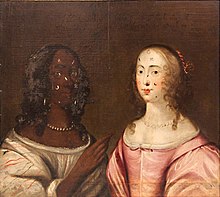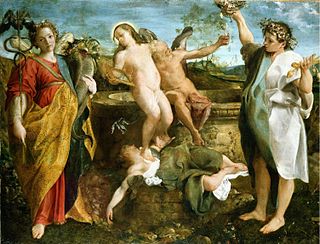
A hierarchy of genres is any formalization which ranks different genres in an art form in terms of their prestige and cultural value.

Bartholomeus van der Helst was a Dutch painter. Considered to be one of the leading portrait painters of the Dutch Golden Age, his elegant portraits gained him the patronage of Amsterdam's elite as well as the Stadtholder's circle. Besides portraits, van der Helst painted a few genre pictures as well as some biblical scenes and mythological subjects.
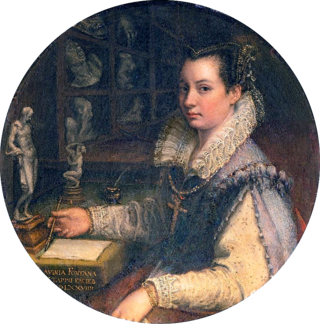
Lavinia Fontana was an Italian Mannerist painter active in Bologna and Rome. She is best known for her successful portraiture, but also worked in the genres of mythology and religious painting. She was trained by her father, Prospero Fontana. She is regarded as the first female career artist in Western Europe, as she relied on commissions for her income. Her family relied on her career as a painter, and her husband served as her agent and raised their 11 children. She was perhaps the first female artist to paint female nudes, but this is a topic of controversy among art historians.

Gonzales Coques was a Flemish painter of portraits and history paintings. Because of his artistic proximity to and emulation with Anthony van Dyck he received the nickname de kleine van Dyck. Coques was also active as an art dealer.

Cornelius Johnson was an English painter of portraits of Dutch or Flemish parentage. He was active in England, from at least 1618 to 1643, when he moved to Middelburg in the Netherlands to escape the English Civil War. Between 1646 and 1652 he lived in Amsterdam, before settling in Utrecht, where he died.

Dutch Golden Age painting is the painting of the Dutch Golden Age, a period in Dutch history roughly spanning the 17th century, during and after the later part of the Eighty Years' War (1568–1648) for Dutch independence.

Pietro Paolini, called il Lucchese was an Italian painter of the Baroque period. Working in Rome, Venice and finally his native Lucca, he was a follower of Caravaggio to whose work he responded in a very personal manner. He founded an Academy in his hometown, which formed the next generation of painters of Lucca.

Michiel Sweerts or Michael Sweerts was a Flemish painter and printmaker of the Baroque period, who is known for his allegorical and genre paintings, portraits and tronies. The artist led an itinerant life and worked in Rome, Brussels, Amsterdam, Persia and India (Goa).

No contemporary physical description of William Shakespeare is known to exist. The two portraits of him that are the most famous are the engraving that appears on the title-page of the First Folio, published in 1623, and the sculpture that adorns his memorial in Stratford upon Avon, which dates from before 1623. Experts and critics have argued that several other paintings from the period may represent him, and more than 60 portraits purporting to be of Shakespeare were offered for sale to the National Portrait Gallery within four decades of its foundation in 1856, but in none of them has Shakespeare's identity been proven.

A tronie is a type of work common in Dutch Golden Age painting and Flemish Baroque painting that depicts an exaggerated or characteristic facial expression. These works were not intended as portraits or caricatures but as studies of expression, type, physiognomy or an interesting character such as an old man or woman, a young woman, the soldier, the shepherdess, the "Oriental", or a person of a particular race.
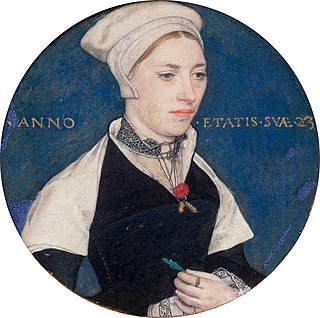
Jane Small (c. 1518–1602) was a daughter of Christopher Pemberton, a Northamptonshire gentleman. She is well known as the subject of a portrait miniature by the famous 16th-century German artist Hans Holbein the Younger, painted about 1540. Holbein was known as a painter of the English court, where his paintings included those of King Henry VIII and several of his wives.

Carpets of Middle-Eastern origin, either from Anatolia, Persia, Armenia, Levant, the Mamluk state of Egypt or Northern Africa, were used as decorative features in Western European paintings from the 14th century onwards. More depictions of Oriental carpets in Renaissance painting survive than actual carpets contemporary with these paintings. Few Middle-Eastern carpets produced before the 17th century remain, though the number of these known has increased in recent decades. Therefore, comparative art-historical research has from its onset in the late 19th century relied on carpets represented in datable European paintings.
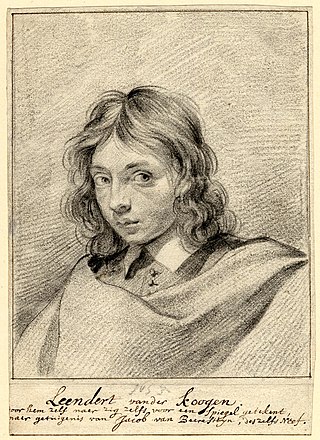
Leendert van der Cooghen was a Dutch painter, draughtsman and printmaker. An amateur artist of independent means, he left a small oeuvre of which his drawings represent the major portion. Recognised by his fellow artists, he was admitted to the Haarlem Guild of Saint Luke in 1652.

Diana and Her Companions is a painting by Dutch artist Johannes Vermeer completed in the early to mid-1650s, now at the Mauritshuis museum in The Hague. Although the exact year is unknown, the work may be the earliest painting of the artist still extant, with some art historians placing it before Christ in the House of Martha and Mary and some after.
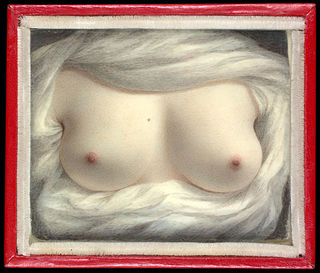
Beauty Revealed is an 1828 self-portrait by the American artist Sarah Goodridge. Depicting only the artist's bared breasts surrounded by white cloth, the 2.6-by-3.1-inch painting, originally backed with paper, is now in a modern frame. Goodridge, aged forty when she completed the watercolor portrait miniature on a piece of ivory, presented the breasts as youthful and individualized. She employed a frontal view that showed only the area from the collarbone to just underneath the breasts, thereby anonymizing the portrait.

Portrait of Dorothea Berck is a 1644 painting by Frans Hals that is in the collection of the Baltimore Museum of Art. It depicts Dorothea Berck at age 51, the wife of the prosperous Haarlem merchant Joseph Coymans, whose portrait Hals also painted. Both paintings were executed on the occasion of their daughter Isabella's wedding, whose marriage pendants Hals also painted.

Oval Portrait of a Woman is a 1633 portrait painting painted by Rembrandt. It shows a woman with a millstone collar and diadem cap. It is in the collection of the Metropolitan Museum of Art.

Nicola or Nicolino or Niccolinovan Houbraken, also known as Nicolino Vanderbrach da Messina and Nicola Messinese was an Italian painter of the late-Baroque who was of Flemish descent. He specialized in paintings depicting playful arrangements of fruits, vegetables, vegetation, animals, game in interiors or in forests. He also painted allegories and garland paintings. His work was appreciated by the Medici court in Florence.

Portrait of a Lady, probably a Member of the Cromwell Family is an oil on panel portrait completed in around 1535–1540 by Hans Holbein the Younger now at the Toledo Museum of Art. The painting shows an elegantly but demurely dressed young woman sitting against a blue-grey background. The subject of this portrait is thought to be a member of the Cromwell family, perhaps Thomas Cromwell's daughter-in-law, Elizabeth Seymour, sister to Jane, third consort of Henry VIII.

Portrait of a Girl is a circa 1632 portrait painting formerly attributed to Rembrandt. It shows a woman with a millstone collar and diadem cap. It was sold on 24 August 2024 for US$1,468,750 in Thomaston, Maine, near where it had been stored since 1970 in the collection of Cary W. Bok. It had been in the collection of Abraham Bredius who lent it for several years to the Mauritshuis, but it landed up in the Philadelphia collection of Mrs. Zimbalist, who in turn left it to her son Cary W. Bok, who outlived his mother by less than a year.
